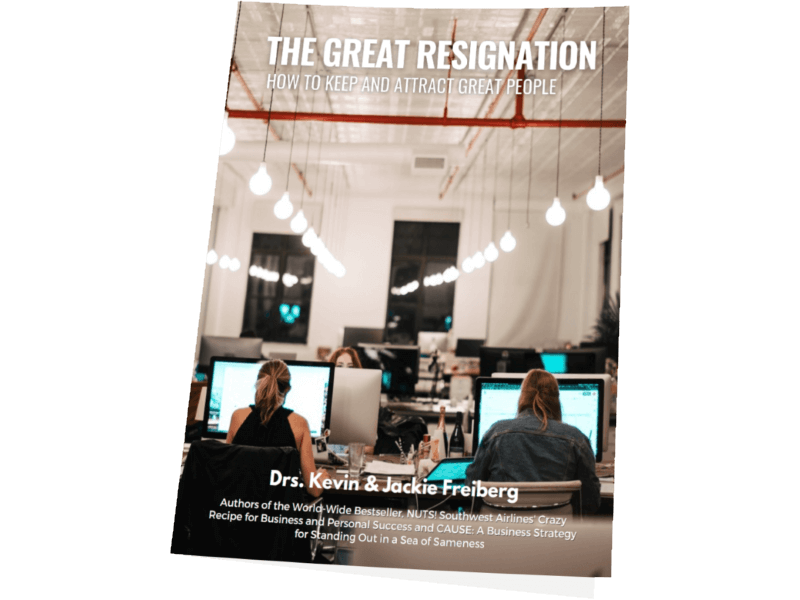Drs. Kevin & Jackie Freiberg
Authors of the World-Wide Bestseller, NUTS! Southwest Airlines’ Crazy Recipe for Business and Personal Success and CAUSE: A Business Strategy for Standing Out in a Sea of Sameness
A CALL FOR COURAGE
In industry after industry, employers can’t find enough workers to fill the demand. The Great Resignation has turned into an unplanned uprising against questionable leadership, organizations that treat people like commodities, and businesses that ignore our greatest human needs. The frustration surfaced in the aftermath of the pandemic. People are courageously asking, “Why am I putting up with this? What’s keeping me from leaving? What if I start my own business?” The result? Priorities have shifted and millions of employees are voting with their feet and walking off their jobs.
People have gained a deeper appreciation for life beyond work. They are in search of good reasons to to stay with a job that is less then fulfilling and simply pays rent. More so than ever, people want opportunities to change, grow, and upskill.
What then are people in search of? Standout cultures that promote and advance empathy, compassion, and various opportunities to flourish at work. And courage is the superpower that allows people at every level to express these qualities with tough minds and tender hearts.
During the pandemic, we experienced the world’s largest work-from-home experiment. Teams that connected frequently and in-person were dispersed. People worked individually in uncertain environments where the boundaries between their personal and professional lives were blurred more than ever. This shift challenged leadership and individual contribution. Whether you planned for it or not, you lived through a macro test of courage – a test of your individual and team response to uncertainty, risk, exposure, and change. For the wise, it was a breeding ground for empathy, curiosity…and courage.
During those times, we looked to our leaders and each other to provide vision, guidance, comfort, and hope. Leadership, particularly in times of crisis, is critical. It’s something we expect from our leaders, institutions and from one another.
Yet, let’s not forget, we are all leaders and your ability to rise strong will be determined by two things. First, your ability to adapt courageously and quickly. Second, your ability to remain hopeful and confident in yourself and others with a plan for paving a way forward.
Unprecedented times… rising gas prices, supply shortages, and labor challenges call for courageous leaders with a fearless mindset. When the economy rebounds, and it will, those who will rise strong will be leaders who embrace the risk and uncertainty with a die-hard resolve for action. There will be no more status quo or “new normal.”
Sorry to say, there is no quick fix. Change is messy and hard. It requires focus, grit, and determination. Although it may be tempting to hunker down, now is the time to get creative, to find new and innovative ways to reconnect, lead and drive the changes that are necessary. Now is the time to re-engage your people and build resilient teams.
Here are 5 strategies to help you be more courageous, inspire courage in others, and rise strong together:
1. TRANSPARENCY AND DECISIVENESS
Businesses across industries are fighting to survive and leaders are having to make very difficult decisions. Hybrid (off-site and in-office) trumps traditional for most people. When given a choice, 87% of people will choose flexibility. So don’t ask, “when will people return to the office.” The more progressive companies are asking, “what will the office of the future look like.”
Naturally, people are resistant and opinionated. Do not allow death by a thousand cuts. The very thing people need now is transparency and decisiveness. Holding off on the inevitable is not kind to people nor smart for the business. If hard and unpopular decisions are required, be courageous, step into the arena and shed the armor. Communicate the best options for the future of the business and let people know what the best way forward for the majority requires. It may be difficult and uncomfortable. Not everyone will agree and not everyone will be happy. So, be prepared and deliver your decisions with EMPATHY. This means share truth with compassion. Pause, listen, and show support.
Courage is stepping into the arena, not ignoring, or avoiding it. Empathy is trying to fully understand what others are experiencing—the good, bad, and emotionally jarring. Empathy is an act of courage, it requires us to be vulnerable by listening, understanding, connecting, supporting, and “figuratively” stepping into what others are experiencing without trying to FIX them or their emotions.
2. NEW RULES OF ENGAGEMENT
Re-evaluate old rules and explore new rules of engagement for adding value.
Courageous leaders know the importance of collective genius—creating a culture that values and appreciates diversity of ideas and opinions. Afterall, creativity and innovation feed on multiple points of view. Yet, the work environment is in flux and transition. Advancing the business will require teams to redefine the rules of engagement and connection. In the current situation, hybrid requires EVERYONE to lead, change and add value. So, rather than being told WHAT to do, people should be inspired to think about what should or could change and what they can do to make the most productive contributions.
Challenge yourself and your team to identify, rethink, and reimagine any antiquated rules, meeting, tenets, or programs that no longer serve the culture and your progress forward.
Now is the time to double down on performance and re-connection in new and fresh ways to get more from everyone. Gallup conducted a 12-year study on remote work trends focused on what teams need from leaders.
In a hybrid environment these are the three performance and connection goals leaders should focus on:
- Accountability — For yourself and for your team, set clear expectations with measurable and regular accountability checks. Some people may want and appreciate regular checks, others may find it disruptive. Ask and lean in respectively. Identify the best ways to support yourself and your team.
- Individualization — One size fits one. Discuss how things are getting done. We all know when, how, and where we are most productive. And perhaps now it’s time to discuss this as a team. Ask: “What is and has been your most efficient and effective workflow?” Identify how to optimize your performance going forward. Some people may have learned they’re more productive working remote, some may struggle in a blurred work/home/virtual environment. Some people may work more efficiently in the morning’s, others in the afternoon or evening. The bigger point, is find ways to optimize the performance of everyone. Do not demand consistency in a hybrid environment; make flexibility and experimentation options. Frequently revisit what is and isn’t working for individuals and for teams.
- Engagement — Hone your strategies for communicating and re-connecting to grow engagement. Is it time to revisit what has become normal? Don’t assume. Check-in and dare to ask your colleagues what needs to change and what might be helpful to grow opportunities for hybrid collaboration and ongoing re-connections.
Track progress, measure results and hold people accountable. The cliché is true: You get what you measure. It doesn’t take people long to figure out, managers measures what they value. Holding yourself and others accountable requires setting clear and transparent expectations and goals and regularly measuring progress, not annually, but weekly. In hybrid environments, weekly updates are essential. If you don’t go to the trouble to measure results, you won’t get the results you want. Tracking progress enables you to know where challenges lie so they can be addressed quickly and efficiently.
Let’s be honest, the environment for anyone going back to work has changed. Are there new standards, new experiences, new workflows, workstations, and platforms? Prepare everyone, don’t assume. It will be different, and people will respond in different ways.
3. BE COURAGEOUS: TAKE INITIATIVE
Throughout our careers, we’ve heard a consistent frustration voiced by most of the executives we work with, and it is this: “Our people ARE empowered, they just don’t ACT empowered.” How valuable are you to your organization if you need to be told what to do?
When change blows through an organization, warning systems go off in people’s minds. Heightened sensitivity, awareness and energy abound. If you don’t move quickly, people will take this energy and waste it on self-protective behavior or fueling the fires of resistance. It’s easy to lose focus and footing. Unless there is a compelling vision to focus everyone’s attention, fear and doubt will take over.
Stay focused and remember, your job uniquely qualifies you to understand pain points, opportunities, and pivot options. Do not hold back, now is the time to review and rethink how operations need to adapt for advancing the business. Ask, “are there any opportunities for improvement and growth?” The transition back to work is calling for leaders at all levels, for people who don’t wait to be asked. Success requires everyone, regardless of position and title, to jump in and prove their mettle by adding value.
What can you do? Initiative isn’t something someone gives you – you take it.
- Move past your title and see beyond your job description. Look for opportunities to pivot, improve and streamline.
- See a problem? Don’t walk past it. Come up with a solution. Own it, personalize it, and elevate it.
- Stop waiting for directions and create your own. Standing still is never a good option, move.
- Think big. Businesses are facing enormous challenges right now and they need far-reaching solutions.
- Be brave, dare to advance your ideas.
- Develop and re-skill. Move beyond your expertise and knowledge. Find opportunities to re-engage, re-think, and re-image the work you do and the value you add.
Borrow from other industries. Sadly, some restaurants and small businesses are closed for good, yet others are crushing it. Chick-Fil-A, morning, noon, and night, has pick-up lanes that fill parking lots and are often lines of cars deep.
Mobile ordering is a digital dream, and the drive-up process is safe and efficient every step of the way.
What can you do to borrow from mobile and digital connections and delivery to keep advancing your business? And, in the spirit of re-imaging not just the business model but re-imaging you, don’t wait for an order or an invitation. This is your opportunity to add value, go for it and re-skill!
4. GET CURIOUS TOGETHER
The world has shifted and will continue to do so. Now is not the time to drain the creative spirits around you by “yeah butting” ideas to death. Now is the time for “what-ifing new ideas, innovations, and discovery to life to create safe new work and life experiences.
Thriving is not only about changing the rules, but also about changing the rulemakers. If you’re bringing more of the same to the table, you won’t have a place there much longer. Who are the people around you moving fast, adding value, and bringing ideas to life? Creativity and action are contagious – join in to fuel the progress. Change isn’t always broadsweeping, change can be incremental. So, don’t feel like you have to shift the titanic. You can affect change one project, one initiative, one connection at a time. The goal here is to be creative and shift.
As work and life transitions continue, the world is calling for GOOD ideas, and good ideas come from those who are courageous and curious. Good ideas come from idea accelerators. Are you seeing the invisible, feeling the intangible, and achieving what others claim to be impossible? Are you asking, “Why? What else? What if? What’s next?” Not once but five times over? You should be.
Put a stop to statements like these:
- We’ve already tried that.
- Yes, but…
- “They” will never buy into it.
- It’s not possible.
- It’s too expensive.
- It’s not realistic.
- It’s not feasible.
- It’s too time-consuming.
These responses to new ideas will END conversations before they can bear fruit. New ideas are the lifeblood of change, innovation and… advancing your business. To accelerate new ideas, you should listen and give space to new ways of moving forward.
Create a team brainstorming session and participate using statements of curiosity like these:
- Interesting, tell me more…
- Help me understand the positive
impact. - Can you cost it out?
- What is your timeframe?
- Who else should you share this with?
- What kind of support would you need to take this idea further?
- What stakeholders will be impacted?
5. REMOVE OBSTACLES
Energy will shift away from uncertainty and chaos, and gravitate toward clear goals and determination. Remember, conviction and resolve are contagious, share your progress, it may motivate others. Tangible pay-offs fuel the fires of motivation.
You’ll gain respect and credibility by removing obstacles and breaking the chains of bureaucracy. For countless people, the blend of work and home over the last two years has heightened our focus on efficiency. Optimization of work flow is on the rise and is not going away. We’ve navigated new rules and procedures for safety, prevention, service and cross functional collaboration. The silver lining, people are adaptive, relevant, and operationally flexible.
And, as virtual work continues, people are quickly realizing less corporate bureaucracy paves the way for more initiative and more creativity. Acknowledge, talk about, and celebrate these new-found freedoms. Create weekly performance and progress updates, include conversations around obstacles that may still be inhibiting progress. Celebrate new freedoms that have inspired creativity and led to improvements, positive pivots, and efficiencies.
Dare to ask:
- What obstacles are getting in your way?
- What is inhibiting your ability to innovate, steam-line and connect?
Think about creating consistent opportunities to share best practices. Creative forums for people to share lessons learned will accelerate engagement and inspire greater levels of creativity. Share best practices for getting shit done AND having fun. The key here is to invite people to share wins, failures, and lessons learned. Wins build team chemistry, failures and lessons learned build team resilience, and collective high fives inspire ongoing engagement and progress.
Be warned, just because a sense of normal might be settling in, now is not the time to get comfortable and complacent. Many people are still working remote and will not go back. Leadership needs to be deployed not just onsite, but hybrid and virtual as well. According to Forbes, more than a quarter of CEOs believe we will not return to the pre-pandemic work requirements or whatever unfolds until 2023, so buckle up. We may never return to a pre-pandemic way of life and work.
Let’s not be complacent. We all must lead and live with a strong bias for action, an empathic spirit, and an unrelenting desire to do our part in achieving a better tomorrow. Let’s be courageous together – courage is the superpower that leads to trust, learning, shifting and rising strong.



